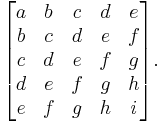Hankel matrix
In linear algebra, a Hankel matrix (or catalecticant matrix), named after Hermann Hankel, is a square matrix with constant skew-diagonals (positive sloping diagonals), e.g.:
If the i,j element of A is denoted Ai,j, then we have
The Hankel matrix is closely related to the Toeplitz matrix (a Hankel matrix is an upside-down Toeplitz matrix). For a special case of this matrix see Hilbert matrix.
A Hankel operator on a Hilbert space is one whose matrix with respect to an orthonormal basis is an infinite Hankel matrix  , where
, where  depends only on
depends only on  .
.
The determinant of a Hankel matrix is called a catalecticant.
Contents |
Hankel transform
The Hankel transform is the name sometimes given to the transformation of a sequence, where the transformed sequence corresponds to the determinant of the Hankel matrix. That is, the sequence  is the Hankel transform of the sequence
is the Hankel transform of the sequence  when
when
Here,  is the Hankel matrix of the sequence
is the Hankel matrix of the sequence  . The Hankel transform is invariant under the binomial transform of a sequence. That is, if one writes
. The Hankel transform is invariant under the binomial transform of a sequence. That is, if one writes
as the binomial transform of the sequence  , then one has
, then one has
Hankel matrices for system identification
Hankel matrices are formed when given a sequence of output data and a realization of an underlying state-space or hidden Markov model is desired. The singular value decomposition of the Hankel matrix provides a means of computing the A, B, and C matrices which define the state-space realization.
Orthogonal polynomials on the real line
Positive Hankel matrices and the Hamburger moment problems
Orthogonal polynomials on the real line
Tridiagonal model of positive Hankel operators
See also
- Hamburger moment problem
- Toeplitz matrix, a Hankel matrix 'upside-down'.
References
- J.R. Partington (1988). An introduction to Hankel operators. LMS Student Texts. 13. Cambridge University Press. ISBN 0-521-36791-3.




